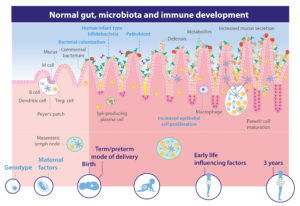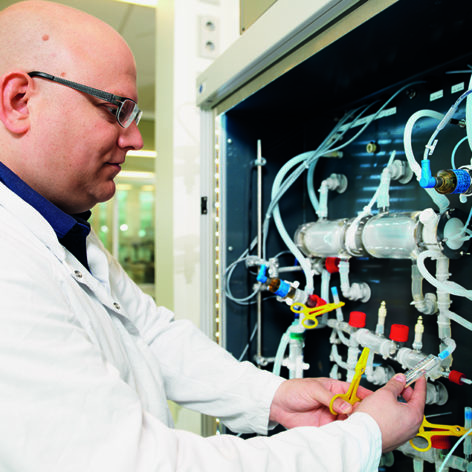The first 1000 days lay the foundation for a child’s future health.1Godfrey K, Gluckman P, Hanson M, Developmental origins of metabolic disease: life course and intergenerational perspectives. Trends Endocrinol Metab. Published on 2010;21(4):199-205 During this critical period, the infant’s gastrointestinal tract undergoes rapid growth and development, including the establishment of the gut microbiota. This involves the colonisation of the gastrointestinal tract by a vast array of microorganisms, including an estimated 100 trillion bacteria.2Mitsuoka T del. del. Intestinal flora and aging. Nutr Rev. Published on 1992;50:438-46
The composition of the gut microbiota changes over time, in response to the infant’s external environment and nutrition. The very first microbes to colonise the gut after birth are bacteria such as E. coli and Streptococci sp. Next, Staphylococcus, Enterococcus and Lactobacillus-like species take over.3Orrhage K, Nord C, Factors controlling the bacterial colonization of the intestine in breastfed infants. Acta Paediatr Suppl. Published on 1999;88(430):47-57 By around 1 week of age, Bifidobacterium is the dominant species in human milk-fed infants. The major driver of change is the introduction of weaning food. With the introduction of solid foods, the gut is colonised with an increasing number and diversity of bacteria until, around 3 years of age, the microbiota has stabilised and resembles that of an adult.4Harmsen H, Wildeboer-Veloo A, Raangs G, del. et al. Analysis of intestinal flora development in breast-fed and formula-fed infants by using molecular identification and detection methods. J Pediatr … Continue reading
Immunity through the gut
While the microbiota is developing in the gut, the infant’s immune system also further develops after birth. The immune system is a complex network of specialised organs, tissues, cells, proteins, and other substances whose job is to protect the body from pathogens. These may include bacteria, viruses, fungi, parasites, foreign cells and many others. This development is crucial as infants move from a protected environment in the womb to one where the immune system has to act, adapt and be resilient. Infants are particularly susceptible to infections in the first days and weeks after birth, as their immune system is not yet fully functional.5Scholtens P, Oozeer R, Martin R, Amor K, Knol J, The early settlers: intestinal microbiology in early life. Annu Rev Food Sci Technol. Published on 2012;3:425-447 Over time, the infant immune system has to learn to defend against invaders and to tolerate harmless substances.6Martin R, Nauta AJ, Amor KB, Knippels LMJ, Knol J, Garssen J, Early life: gut microbiota and immune development in infancy. Benef Microbe. Published on 2010;1:367-82
The gut is the largest immune organ
Around 70-80% of the immune cells are located in the gut – specifically, within the inside lining of the intestines, in a single layer of cells known as the “epithelium”.7Furness J, Kunze W, Clerc N, Nutrient tasting and signaling mechanisms in the gut. II. The intestine as a sensory organ: neural, endocrine, and immune responses. Am J Physiol. Published on 1999;277(5 … Continue reading Because the intestines are long, and the lining is highly folded, the gut epithelium represents the body’s largest and most important interface with the outside world. By acting as a physical barrier, and by hosting many of the body’s immune cells and tissues, the gut epithelium is part of the first line of defence against potentially harmful substances.

A healthy gut microbiota and gut is essential for a healthy immune system
An infant’s gut microbiota and gut plays a key role in promoting good health and immunity in the first years of life. A healthy microbiota – characterised by a diverse and well-balanced array of microbes – can directly protect against intestinal pathogens. Furthermore, a healthy gut microbiota is necessary for the development of a resilient and well-functioning immune system. 8Martin R, Nauta AJ, Amor KB, Knippels LMJ, Knol J, Garssen J, Early life: gut microbiota and immune development in infancy. Benef Microbe. Published on 2010;1:367-82 ,9Wopereis H, Oozeer R, Knipping K, Belzer C, Knol J, The first thousand days – intestinal microbiology of early life: establishing a symbiosis. Pediatr Allergy Immunol. Published on … Continue reading
Developing and maintaining a balance between the intestinal microbiota and the immune system is thus an essential and dynamic process during the first 1000 days and beyond, influencing lifelong health.10Wopereis H, Oozeer R, Knipping K, Belzer C, Knol J, The first thousand days – intestinal microbiology of early life: establishing a symbiosis. Pediatr Allergy Immunol. Published on … Continue reading,11Prescott SL, Origins: Early-life solutions to the modern health crisis. University of Western Australia Press 2015 Crawly, Western Australia.
The gut-brain axis
Also the gut and brain are closely linked. The gut harbors a vast network of millions of neurons and in this way, the gut influences the brain and vice-versa via the gut-brain axis. The complex microbiota-gut-brain communication is driven by a variety of pathways including barrier function, hormonal and neural regulation, as well as via immune and metabolic pathways. Early life nutrition is a crucial factor that can influence both gut microbiota and may affect brain development, although the precise modes of action are still not known. Further understanding of the complexity of the microbiota-gut-brain relationship and the window of opportunity for nutrition to promote normal brain development in early life is.12Wang S, Harvey L, Martin R, et al. Targeting the gut microbiota to influence brain development and function in early life. Neurosci Biobehav Rev. Published on 2018;95:191-201
View References
| 1 | Godfrey K, Gluckman P, Hanson M, Developmental origins of metabolic disease: life course and intergenerational perspectives. Trends Endocrinol Metab. Published on 2010;21(4):199-205 |
|---|---|
| 2 | Mitsuoka T del. del. Intestinal flora and aging. Nutr Rev. Published on 1992;50:438-46 |
| 3 | Orrhage K, Nord C, Factors controlling the bacterial colonization of the intestine in breastfed infants. Acta Paediatr Suppl. Published on 1999;88(430):47-57 |
| 4 | Harmsen H, Wildeboer-Veloo A, Raangs G, del. et al. Analysis of intestinal flora development in breast-fed and formula-fed infants by using molecular identification and detection methods. J Pediatr Gastroenterol Nutr. Published on 2000;30(1):61-67 |
| 5 | Scholtens P, Oozeer R, Martin R, Amor K, Knol J, The early settlers: intestinal microbiology in early life. Annu Rev Food Sci Technol. Published on 2012;3:425-447 |
| 6, 8 | Martin R, Nauta AJ, Amor KB, Knippels LMJ, Knol J, Garssen J, Early life: gut microbiota and immune development in infancy. Benef Microbe. Published on 2010;1:367-82 |
| 7 | Furness J, Kunze W, Clerc N, Nutrient tasting and signaling mechanisms in the gut. II. The intestine as a sensory organ: neural, endocrine, and immune responses. Am J Physiol. Published on 1999;277(5 Pt 1):G922-8 |
| 9, 10 | Wopereis H, Oozeer R, Knipping K, Belzer C, Knol J, The first thousand days – intestinal microbiology of early life: establishing a symbiosis. Pediatr Allergy Immunol. Published on 2014;25(5):428-438 |
| 11 | Prescott SL, Origins: Early-life solutions to the modern health crisis. University of Western Australia Press 2015 Crawly, Western Australia. |
| 12 | Wang S, Harvey L, Martin R, et al. Targeting the gut microbiota to influence brain development and function in early life. Neurosci Biobehav Rev. Published on 2018;95:191-201 |



